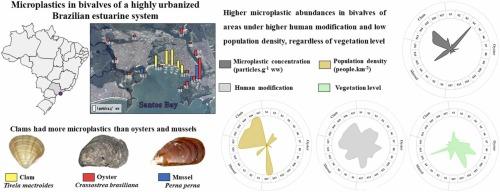巴西城市化河口双壳类动物体内的微塑料:人类活动、人口密度和植被的影响
IF 12.2
1区 环境科学与生态学
Q1 ENGINEERING, ENVIRONMENTAL
引用次数: 0
摘要
微塑料(MPs)对全球的影响无处不在,尤其是在人为压力巨大的沿海地区,而这些地区的监测工作却十分有限。双壳类动物是微塑料污染的重要哨兵。这项调查确定了巴西桑托斯-圣维森特(Santos-São Vicente)的牡蛎、蛤蜊和贻贝中的多溴联苯醚污染情况,重点关注社会环境预测因素、空间分布和物种间变化。MPs水平的升高与较高的人为改造(β = 0.5747,p = 0.0223)和人口密度的降低(β = -8.918e-06,p = 0.0443)有关,与植被覆盖度无关(p > 0.05)。人口密度与 MP 污染之间的负相关是由于工业和港口活动的大量存在,导致尽管人口较少,但 MP 排放量较高。这三个物种同时出现在特定地点,对广泛的空间研究来说是一个内在的限制,这取决于它们的环境可用性。尽管蛤类的 MP 浓度较高,但贻贝和牡蛎的 MP 浓度也表现出空间变化,可作为合适的哨兵。河口中部和左部的 MP 浓度较高,与众所周知的污染梯度一致。与贻贝(0.72 ± 1.07 [0.00 - 7.74] 颗粒.g-1)和牡蛎(0.70 ± 1.03 [0.00 - 7.70] 颗粒.g-1)相比,蛤蜊积累了更多的 MPs(1.97 ± 1.37 [0.00 - 5.55] 颗粒.g-1),这表明沉积物中的生物利用率高于水体。在所有物种中发现的 MPs 主要较小(1,000 µm)、碎片或纤维,且无色。这些发现通过将 MPs 浓度与社会环境预测因素联系起来,为未来的全球调查奠定了基础,有助于制定当地的缓解措施和开展全球讨论。本文章由计算机程序翻译,如有差异,请以英文原文为准。

Microplastic in bivalves of an urbanized Brazilian estuary: Human modification, population density and vegetation influence
Microplastics (MPs) global ubiquitously affects particularly coastal regions under significant anthropogenic pressures, where there are limited monitoring efforts. Bivalves are valuable sentinels of MPs contamination. This investigation determined MP contamination in oysters, clams, and mussels at Santos-São Vicente, a heavily urbanized estuary in Brazil, focusing on socio-environmental predictors, spatial distribution, and interspecies variations. Elevated MPs levels were linked to higher human modification (β = 0.5747, p = 0.0223) and reduced population density (β = −8.918e-06, p = 0.0443), regardless of vegetation cover (p > 0.05). Such a negative connection between population density and MP contamination occurred due to the significant presence of industrial and port activities, leading to high MP discharges despite a low population. The simultaneous presence of the three species at specific sites is an intrinsic limitation for broad spatial studies, depending on their environmental availability. Despite higher concentrations in clams, mussels and oysters also exhibited spatial variations in MP concentrations, serving as suitable sentinels. The central and left segments of the estuary displayed elevated MP concentrations, consistent with a well-known contamination gradient. Clams accumulated more MPs (1.97 ± 1.37 [0.00 – 5.55] particles.g−1) than mussels (0.72 ± 1.07 [0.00 – 7.74] particles.g−1) and oysters (0.70 ± 1.03 [0.00 – 7.70] particles.g−1), suggesting higher bioavailability in sediments than the water column. MPs found across all species were predominantly smaller (<1000 µm), fragments or fibers, and colorless. These discoveries lay a groundwork for prospective global investigations by linking MPs concentrations to socio-environmental predictors, contributing to the development of local mitigation measures and global discussions.
求助全文
通过发布文献求助,成功后即可免费获取论文全文。
去求助
来源期刊

Journal of Hazardous Materials
工程技术-工程:环境
CiteScore
25.40
自引率
5.90%
发文量
3059
审稿时长
58 days
期刊介绍:
The Journal of Hazardous Materials serves as a global platform for promoting cutting-edge research in the field of Environmental Science and Engineering. Our publication features a wide range of articles, including full-length research papers, review articles, and perspectives, with the aim of enhancing our understanding of the dangers and risks associated with various materials concerning public health and the environment. It is important to note that the term "environmental contaminants" refers specifically to substances that pose hazardous effects through contamination, while excluding those that do not have such impacts on the environment or human health. Moreover, we emphasize the distinction between wastes and hazardous materials in order to provide further clarity on the scope of the journal. We have a keen interest in exploring specific compounds and microbial agents that have adverse effects on the environment.
 求助内容:
求助内容: 应助结果提醒方式:
应助结果提醒方式:


